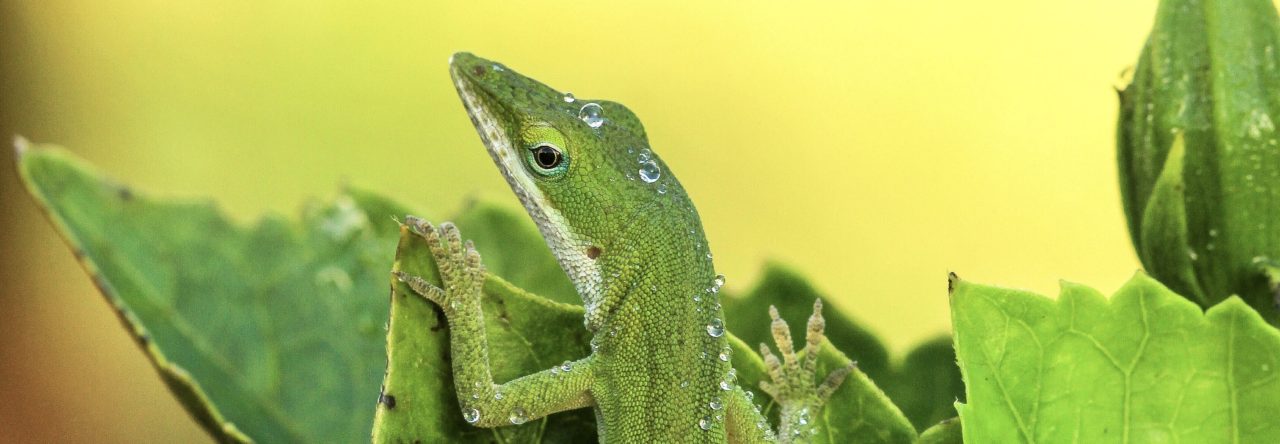With the 2013 Herp Meetings in Albuquerque coming to a close, there have been some great anole posters presented over the 3 poster sessions. I spoke with some of the presenters about their exciting results.

Kristin Winchell presenting her award-winning poster at the Friday ASIH poster session.
SSAR Student Poster Winner Kristin Winchell of the Revell Lab studied differences in morphology in urban and natural Anolis cristatellus populations in Puerto Rico. Kristin found that urban populations had longer limbs, more subdigital lamellae and higher body temperatures than natural populations of lizards. She believes these morphological features are adaptations for clinging to the broad, smooth surfaces of an urban landscape. She will continue this work by using a common-garden setup to rule out phenotypic plasticity as the cause of these differences. This is an interesting study that will hopefully inspire more research on how reptiles will adapt to an increasingly urban world. You can read more about Kristin’s research on her website. Congratulations Kristin!

Ian Latella’s poster on changes in anole habitat use in All-American Park in Miami, FL.
Continuing with the theme of anoles in human-mediated environments, Ian Latella of the Poe lab presented his poster on changes in a small, introduced Anolis community. An assemblage of six introduced species reside in All-America Park in Miami: A. distichus, A. equestris, A. garmani, A. porcatus, A. sagrei, and A. cristatellus. This provides a natural experiment for investigating invasion dynamics and short-term community assembly. Ian compared data on habitat use from 2002 and 2012 to identify changes across time. The preliminary results are interesting: after a 10 year period, A. sagrei utilized higher perches, while A. porcatus switched to lower perch heights.

Aja King of Steven Poe’s lab presenting her poster on island differences in A. allisoni.
Aja King, also from the Poe lab, was interested in comparing A. allisoni populations in Cuba and the Bay Islands. She constructed a molecular phylogeny containing specimens from Cuban and Bay Island populations. Her phylogeny showed that the Bay Island populations nested within an Eastern Cuba clade, suggesting the possibility of an invasion of the Bay Islands from Cuba. Aja also performed a discriminant function analysis to look for differences in continuous morphological characters. She was excited that the Bay Island and Cuban populations were significantly different with respect to morphology: she could correctly identify the island of origin based on specimen morphology every time!

Poster from Steven Poe describing their in-progress computerized key.
Steven Poe, New Mexico’s local anole expert, presented his poster on Sunday publicizing the lab’s efforts to develop a computerized Anolis key. The key would include all 381 species of Anolis. Rather than a dichotomous key-style approach, the user would check a series of boxes representing character states. The key would then search through the species matching the set of inputted characters. This project would lead to an app-style user interface that researchers could use on the go. This will be a great resource for professional and hobbyist herpetologists alike.

Kirsten Nicholson’s poster on South-North expansion of Norops capito.
Kirsten Nicholson, professor at Central Michigan University, presented some of the results of her phylogeographic study on Norops capito, a mainland species. Previous hypotheses suggested that members of the Norops group originated in the Caribbean after the separation of North and South America and the break-up of Caribbean islands, dispersing overwater to Mexico and then moving southward. Kirsten’s molecular phylogeny of N. capito shows a contrasting pattern. Panamanian individuals form an outgroup, with Costa Rican, Nicaraguan, and Honduran individuals nested within. This suggests a South->North dispersal pattern. Along with N. limifrons, this is the second species to show this pattern. Kirsten plans to estimate divergence times from her data to further elucidate the picture of anole dispersal.
The 2013 Herp Meetings have showcased an assortment of great ongoing anole projects. What a great venue for drawing the anole community together! Check back soon for more on the conference.

















 Eminent herpetologist Laurie Vitt, recently retired from the University of Oklahoma (but active as ever), gave the Distinguished Herpetologist’s Lecture at the 2012 Annual Meeting of the Herpetologists League, which was part of The World Congress of Herpetology 7. The talk, the basis of a
Eminent herpetologist Laurie Vitt, recently retired from the University of Oklahoma (but active as ever), gave the Distinguished Herpetologist’s Lecture at the 2012 Annual Meeting of the Herpetologists League, which was part of The World Congress of Herpetology 7. The talk, the basis of a 
 A year ago,
A year ago,